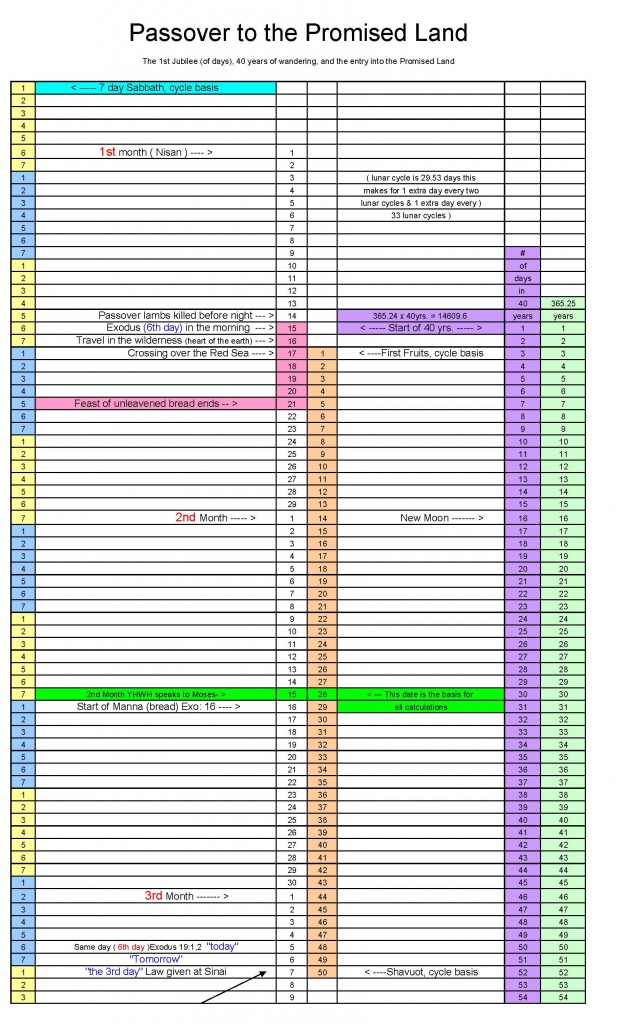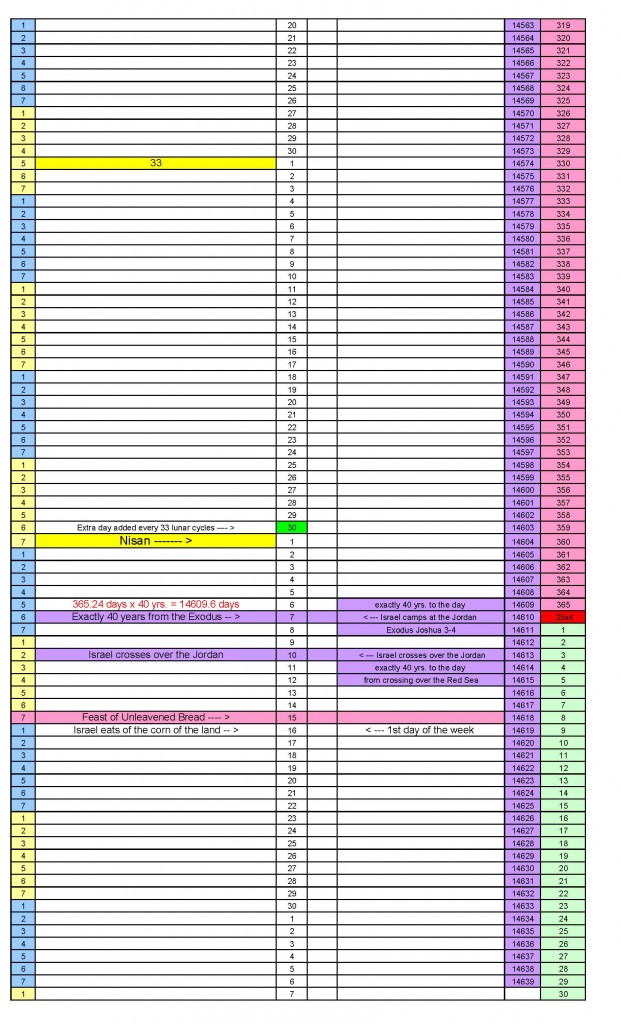Yeas ago I set out to see if I could figure out exactly what day Israel crossed over the Jordan river into the Promised Land. Based upon my calculations Israel camped at the Jordan river exactly 40 years, to the day, from the Exodus of Egypt. Further, exactly 40 years, to the day, from the Red Sea crossing , Israel crossed over the Jordan river into the Promised Land. Take a look and see what you think.
Click on Image for full size:


I only included the first and last pages of my chart. The entire 188 page chart in PDF format can be found here: Passover to the Promised Land
Numbers 14:33-34 And your children shall wander in the wilderness forty years, and bear your whoredoms, until your carcases be wasted in the wilderness. After the number of the days in which ye searched the land, even forty days, each day for a year, shall ye bear your iniquities, even forty years, and ye shall know my breach of promise.
Joshua 5:6-12 For the children of Israel walked forty years in the wilderness, till all the people that were men of war, which came out of Egypt, were consumed, because they obeyed not the voice of YHWH: unto whom YHWH sware that he would not shew them the land, which YHWH sware unto their fathers that he would give us, a land that floweth with milk and honey. And their children, whom he raised up in their stead, them Joshua circumcised: for they were uncircumcised, because they had not circumcised them by the way. nd it came to pass, when they had done circumcising all the people, that they abode in their places in the camp, till they were whole. And YHWH said unto Joshua, This day have I rolled away the reproach of Egypt from off you. Wherefore the name of the place is called Gilgal unto this day. And the children of Israel encamped in Gilgal, and kept the passover on the fourteenth day of the month at even in the plains of Jericho. And they did eat of the old corn of the land on the morrow after the passover, unleavened cakes, and parched corn in the selfsame day. And the manna ceased on the morrow after they had eaten of the old corn of the land; neither had the children of Israel manna any more; but they did eat of the fruit of the land of Canaan that year.




Your calculation assumes Moses led Israel across the Red Sea on that first day of the Exodus, but that is highly unlikely. It would have taken several days to move 3 million people, plus livestock, all the way around to the eastern side of the Sinai Peninsula where the crossing likely took place. They didn’t cross through the Sea of Reeds where the Suez Canal now runs, but at what is now Dahab on the eastern side of the peninsula. There is a land shelf there that crosses the main body of the Red Sea to Saudi Arabia. Underwater archaeological work there has revealed the remains of Egyptian chariots. The Biblical Mt Sinai is really Jebal al Lawz in Saudi. Archaeological work there has been suppressed and the area bulldozed and sealed off after the remain of twelve pillars and hundreds of ancient Jewish gold artifacts were found there in the 1990’s. The nomads there have called it the Mountain of Moses for centuries.
Hi Braxton,
I’m sorry I don’t have much time tonight to fully address your excellent comments. I hope to make a blog post in the near future on the subject. Here are some old notes of mine which I just pasted to a separate blog page. At least you will get an idea of how I look at the subject.
Regards,
William Struse
http://www.the13thenumeration.com/Blog13/the-red-sea-crossing/
William,
Your conclusion is well thought out and there are certainly scriptural reasons for questioning the alternative routes. But there are also scriptural reasons for questioning the traditional route. Cornuke’s description of the traditional Mt. Sinai and of Jebal al Lawz show the latter better fitting the Biblical description. You also use assumptions about water levels. In reality, we don’t know what the levels were at the time. The topography, too, could have been different but all of that is supposition. Finally, although only 3 camps were mentioned in the Biblical narrative, there could have been more. Like any narrator, Moses might have used “highlights of the trip,” not a boring, detailed AAA Triptik of the route. But again, supposition.
The only hard evidence is archaeological. Ancient chariots have been found off Nuweiba Beach along a land bridge there. The remains of ancient pillars, along with gold Israelite artifacts were discovered at the base of Jebal al Lawz. The National Museum of Saudi Arabia, in Riyadh, had a huge display of these items in the mid 1990’s. It was removed to storage after just 2-3 weeks at the demand of the mullahs. After Cornuke’s book came out, those same religious leaders had the area at Jebal al Lawz bulldozed and the archaeological site destroyed. Now, the entire area is cordoned off and accessible only by the military. I, at one point, had two photos of the exhibit that were taken illicitly by a friend who worked in Riyadh as a nurse at the time. A week later, the exhibit was gone. She also was able to visit the archaeological site before it was destroyed, although she and her male companion were not allowed to walk around or explore it because the military had already taken control of the area. Her description of the mountain itself corroborated Cornuke’s.
In the end, what really matters is that the Exodus is a type and foreshadowed our leaving sin behind and accepting Christ and His promise of a new life.